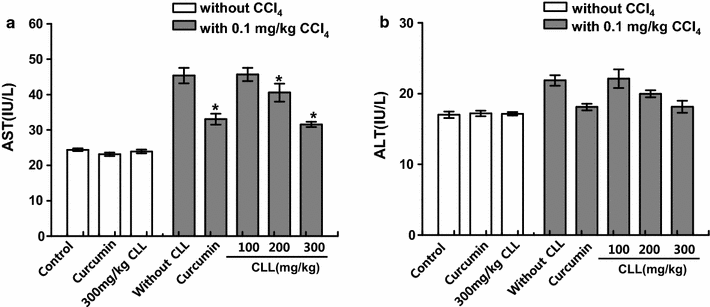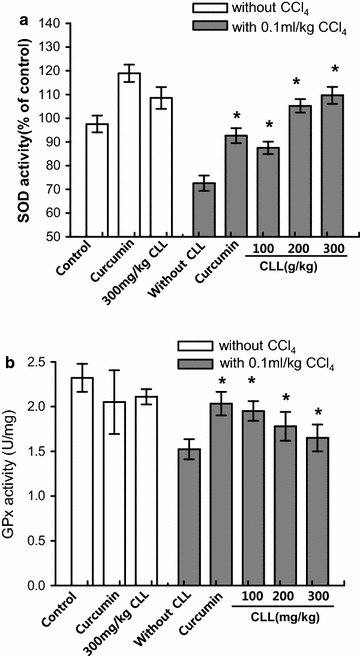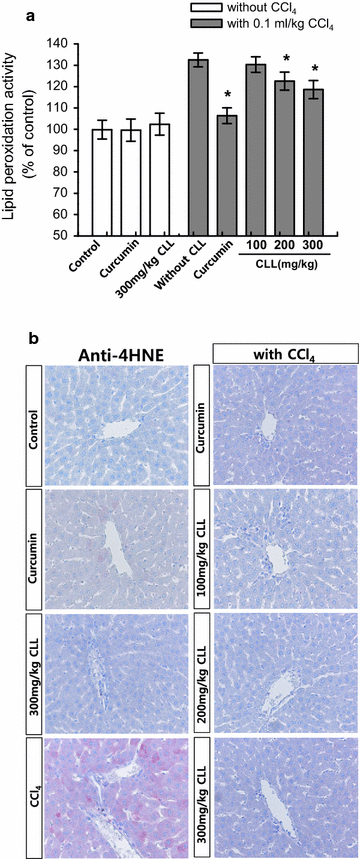Protective effect of Curcuma longa L. extract on CCl4-induced acute hepatic stress
- PMID: 28143589
- PMCID: PMC5286822
- DOI: 10.1186/s13104-017-2409-z
Protective effect of Curcuma longa L. extract on CCl4-induced acute hepatic stress
Expression of concern in
-
Editorial expression of concern: Protective effect of Curcuma longa L. extract on CCl4-induced acute hepatic stress.BMC Res Notes. 2024 Jun 11;17(1):161. doi: 10.1186/s13104-024-06818-4. BMC Res Notes. 2024. PMID: 38863008 Free PMC article. No abstract available.
Abstract
Background: The Curcuma longa L. (CLL) rhizome has long been used to treat patients with hepatic dysfunction. CLL is a member of the ginger family of spices that are widely used in China, India, and Japan, and is a common spice, coloring, flavoring, and traditional medicine. This study was performed to evaluate the hepatoprotective activity of CLL extract and its active component curcumin in an acute carbon tetrachloride (CCl4)-induced liver stress model.
Methods: Acute hepatic stress was induced by a single intraperitoneal injection of CCl4 (0.1 ml/kg body weight) in rats. CLL extract was administered once a day for 3 days at three dose levels (100, 200, and 300 mg/kg/day) and curcumin was administered once a day at the 200 mg/kg/day. We performed alanine transaminase (ALT) and aspartate transaminase (AST). activity analysis and also measured total lipid, triglyceride, and cholesterol levels, and lipid peroxidation.
Results: At 100 g CLL, the curcuminoid components curcumin (901.63 ± 5.37 mg/100 g), bis-demethoxycurcumin (108.28 ± 2.89 mg/100 g), and demethoxycurcumin (234.85 ± 1.85 mg/100 g) were quantified through high liquid chromatography analysis. In CCl4-treated rats, serum AST and ALT levels increased 2.1- and 1.2-fold compared with the control. AST but not ALT elevation induced by CCl4 was significantly alleviated in CLL- and curcumin-treated rats. Peroxidation of membrane lipids in the liver was significantly prevented by CLL (100, 200, and 300 mg/kg/day) on tissue lipid peroxidation assay and immunostaining with anti-4HNE antibody. We found that CLL extract and curcumin exhibited significant protection against liver injury by improving hepatic superoxide dismutase (p < 0.05) and glutathione peroxidase activity, and glutathione content in the CCl4-treated group (p < 0.05), leading to a reduced lipid peroxidase level.
Conclusion: Our data suggested that CLL extract and curcumin protect the liver from acute CCl4-induced injury in a rodent model by suppressing hepatic oxidative stress. Therefore, CLL extract and curcumin are potential therapeutic antioxidant agents against acute hepatotoxicity.
Keywords: CLL extract; Curcumin; GSH; Hepatotoxicity; Lipid peroxidation.
Figures





References
-
- Rezaei-Moghadam A, Mohajeri D, Rafiei B, Dizaji R, Azhdari A, Yeganehzad M, Shahidi M, Mazani M. Effect of turmeric and carrot seed extracts on serum liver biomarkers and hepatic lipid peroxidation, antioxidant enzymes and total antioxidant status in rats. Bioimpacts. 2012;2(3):151–157. - PMC - PubMed
-
- Li M, Wu Z, Niu W, Wan Y, Zhang L, Shi G, Xi X. The protective effect of curcumin against the 19 kDa Mycobacterium tuberculosis protein-induced inflammation and apoptosis in human macrophages. Mol Med Rep. 2014;10(6):3261–3267. - PubMed
MeSH terms
Substances
LinkOut - more resources
Full Text Sources
Other Literature Sources
Medical
Miscellaneous

